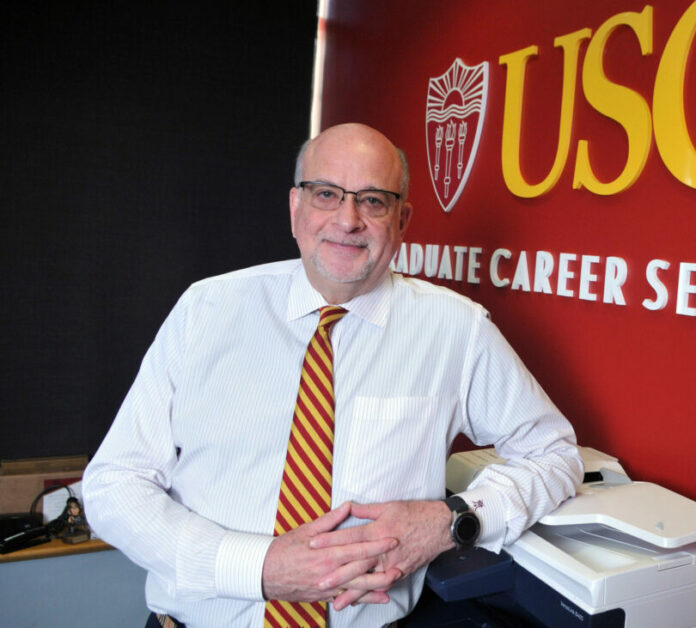Los Angeles Master of Business Administration programs are back to operating pre-pandemic-style, a return to normality that has come with varying consequences for the programs, their applicants and their students.
One recent trend reported by local MBA programs is a decrease in applications from prospective domestic students.
“We were actually up overall in total application volume (this year), but it essentially came from the international applicants,” Evan Bouffides, assistant dean and director of MBA admissions at the USC Marshall School of Business, said. “A lot of schools experienced not only a decrease in domestic application volume, but also subsequent decrease in their enrollment.”
USC’s MBA program has been bolstered by the increased ability to recruit international students remotely, which Bouffides considered a silver lining to the virtual push necessitated by the pandemic.
“In any given class we might have about 20 or so countries represented. This year, we hit our record and had 30 countries of origin represented,” he said. “We got a lot of representation from parts of the world that we just hadn’t seen before, which is terrific.”
This year, USC’s MBA program brought in an entering class of 190 students, 30 students fewer than its typical number of 220.
“I believe that (having fewer domestic applicants) is a temporary problem,” Bouffides said. “But there’s no doubt that we as business schools are going to have to make sure that we market appropriately and make sure that we’re still on the map for those who are considering graduate management education.”
Bouffides’ assessment is backed up by similarly dwindling domestic application numbers experienced by Pepperdine University’s MBA program.
“In the second half of Covid, demand has just really gone down for MBA programs purely on domestic students in our full-time or part-time MBA,” said Dr. Arman Davtyan, assistant dean of enrollment management at Pepperdine’s Graziadio Business School.
Covid dynamics
In the thick of the pandemic, Davtyan said, there were more reasons for pursuing an MBA.
“Students really were looking for a way to ride out the crisis,” he said. “They were less certain about their professional prospects and general anxiety drove a lot of people to enroll in a business program.”
Free time was a significant factor in students pursuing an MBA in semesters prior, when the pandemic froze or disrupted efficiency in business sectors and recreational activities. What’s more, universities gave prospective students more reason to apply for MBAs with the extension of admission rounds and lowering or removing standardized testing requirements.
According to the business education news outlet Poets & Quants, there was an average increase of nearly 23% in application volume among most top schools near the start of the pandemic.

About two years later, students are now primarily back to in-person instruction and taking advantage of it, according to Mark Brostoff, USC Marshall’s assistant dean and director of MBA Career Services.
USC ranks No. 2 on the Business Journal’s list of MBA programs (see page 22).
Tuition for USC’s full-time MBA, a two-year program, is about $138,000 in total. Students are automatically considered for merit-based scholarship opportunities predicated on factors including work experience, academic history, test scores and interviews.
Pepperdine’s MBA
Pepperdine’s MBA program’s key factors are practical instruction, seasoned faculty, and ethics, according to Davtyan.
The average class size is 26, a result of the program’s emphasis on tight-knit collaboration between students and instructors.
“We want students to be able to go to class in the evening, learn something and turn around the next morning and be able to apply it in their workplace,” Davtyan said.
Some faculty members at Pepperdine are seasoned professionals who conduct consultant work or run companies in addition to their post with the university. According to Davtyan, these faculty members inject the principles formed through their respective businesses into the classroom curriculum.
The university also links its instruction with value systems and ethics that stress students look above and beyond financial success alone. Davtyan said that students engage in business according to ethical principles that are a part of Pepperdine’s faith-based heritage. The full-time MBA can be completed in 12, 15, or 20 months, and costs about $100,000.
Just like USC, Pepperdine offers different types of MBAs and offers merit-based scholarships, which have become increasingly important for marketing the program.
Davtyan noted that the current promising job market makes it difficult to attract new students. The price tag of Pepperdine’s MBA is also a factor, he said.
“I think skilled and educated professionals are having very little trouble getting strong positions and getting paid well, so in that context, enrolling MBA students has become even more competitive,” Davtyan said.
He added that in order to keep pace with students’ desires and curriculum preferences, Pepperdine’s MBA program is analyzing which industries and types of degrees are shifting in and out of demand. That analysis has led to the program considering new degree specializations and short certificate programs.
“I think short term, six weeks or eight weeks or 12-week programs, those kinds of skills-driven education opportunities are becoming more intriguing for us and will hopefully deliver,” Davtyan said.
Pepperdine’s MBA program is ranked No. 3 on the Business Journal’s list. UCLA’s program took the top spot.

